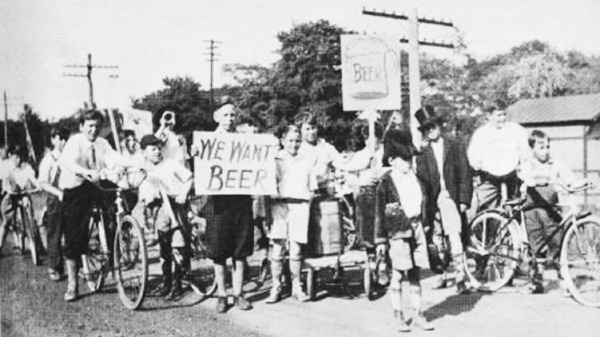
HARRINGTON PARK—One of our favorite photographs taken in Northern Valley history is the one above, depicting the Beer Parade in Harrington Park on May 17, 1932.
Knicker-clad boys hold signs proclaiming “We want beer!” as they take to the streets on their bikes. A couple of them are wearing tuxedo jackets and top hats.
We can just barely see the old Harrington Park train station in the background to the right. The station stood at the corner of La Roche Avenue and Elm Street. In the mid-20th century, it became the headquarters for the Harrington Park Police Department. An electrical fire destroyed it in 1986 and a new police station, which is still in use today, was subsequently built at the same corner.
Of course, none of the boys in this 1932 photograph were actually old enough to drink alcohol. This was a humorous play on an anti-Prohibition march that had taken place in New York City several days earlier.
The Temperance Movement, founded in the early 19th century, urged abstinence from alcohol, identifying intoxication as a catalyst for poverty, social problems, immoral behavior, and violence. By the late 19th and early 20th century the Protestant-based movement was gaining some serious traction, with groups like the Women’s Christian Temperance Union and Anti-Saloon League pushing for an overall ban on the sale of alcoholic beverages. The movement ultimately saw victory with the passage of the 18th Amendment, which rendered the manufacture and sale of alcoholic beverages illegal starting in 1920. This time period in American history is referred to as Prohibition.
By the 1930s it was apparent that Prohibition wasn’t working. People wanted to drink, and where there were willing consumers there were suppliers. In 1930 alone, Americans consumed 2.5 billion gallons of beer. The rural Northern Valley was rife with bootlegging operations.
Those seeking an end to Prohibition often touted the tax revenue that its repeal would bring. If alcohol could be sold in the open and taxed once again, the federal, state, and local governments stood to gain millions in tax dollars—funding that was badly needed at that time, the height of the Great Depression.
On May 14, 1932, New York City Mayor Jimmy Walker organized the “Beer for Taxation” march based on that very idea. An estimated 100,000 people attended this historic event to protest the 18th Amendment. It came to be known as the “We Want Beer!” parade. Similar events were held in other cities in 1932, including one in Paramus on May 20 with a procession of more than 200 cars.
Harrington Park’s beer parade of May 17, 1932 took place after school on that Tuesday afternoon. Youngsters aged 3–15 gathered and prepared for the public protest with banners, drums, costumes, and noisemakers. One little boy played the part of Jimmy Walker. They went through the streets carrying signs displaying foaming glasses of beer and various slogans, drums beating, horns blowing, and every available noisemaker contributing to the commotion. On Dec. 5, 1933, Prohibition ended with the 21st Amendment to the Constitution.
